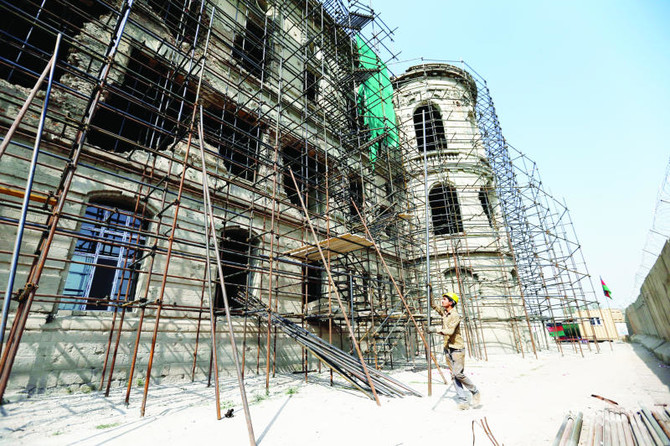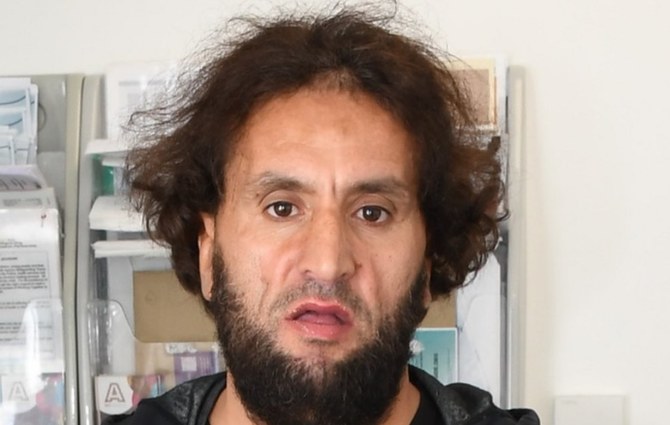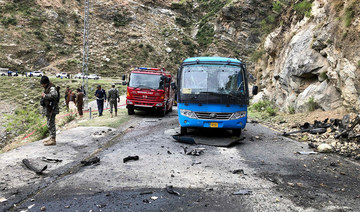KABUL: After years of abandonment, the ruined Darul Aman palace in Kabul, one of the most recognizable symbols of Afghanistan’s decades of war, is to be restored in a project authorities hope will come to symbolize revival instead of destruction.
The aim is an ambitious one, with Afghan forces fighting the Taliban insurgency across the country, Kabul regularly hit by suicide attacks and the broken economy seemingly in no better shape than the bombed-out palace itself.
The project was launched by President Ashraf Ghani in May and Urban Development Minister Sadat Mansoor Naderi said the government hoped the site, next to a new, Indian-financed Parliament, can become the center of a new government quarter as well as a tourist attraction.
For the moment, such goals remain a long way off and the most visible sign of renewal is a crew working on preparing the site for the full reconstruction to come later.
“In the team we’ve built here, we’ve got over 100 young graduates,” Naderi told Reuters during a visit to the site this week.
“Twenty percent of the technical engineers you see here are female,” he said.
In a country where opportunities for women to develop careers are severely limited, the restoration effort, which will depend heavily on support from foreign donors, is a showcase for young graduates.
“This is a historical site and of course it’s a new experience,” said Sofia Roshan, 24, a structural design engineer who graduated recently from a private university in Kabul and has been working at the site for four months.
She said the fact the restoration was so unusual meant there was more freedom for younger engineers and women in particular than there would be in a standard construction project.
“It’s different from a new building so it’s a new experience for everyone. We can learn from the project but we can also share our opinions,” she said.
“People don’t put much value on women in Afghanistan but this project will show that women can do anything.”
Reduced to a shattered skeleton following repeated bombardments over the years, the imposing European-style palace was built in the 1920s by former King Amanullah Khan on a low hilltop just outside the capital.
The edifice was destroyed in the civil wars of the 1990s, when fighting between rival militias killed thousands in Kabul. In the years after the fall of the Taliban, the bullet-scarred wreckage was left empty as a flood of foreign cash fueled a boom in the city around it.
Its abandoned corridors, rooftops open to the sky and the faded graffiti left by passing militia fighters have a ghostly feel as dusty sunlight streams in through cracks in the walls.
“This is the result of war. Think about that,” reads a message scrawled on a corner wall.
Naderi said requests for proposals would soon be issued, inviting foreign companies to bid for work on the project, which could cost up to $20 million, and officials had already sought advice abroad.
The celebrated restoration of the Reichstag in the German capital Berlin, which like the Darul Aman palace was destroyed in war and abandoned for decades and which incorporates many reminders of the destruction, was one model he had looked at.
“Obviously, we are looking at other countries with similar experiences to ours,” he said.
How long the project may take is not clear. Until engineers complete surveys, they will not know the full extent of the damage and how much work will be needed to repair it. Financing must also be worked out and Afghanistan’s unpredictable politics may still create obstacles.
But for Sonia Alizada, one of the young engineers working on the palace, her enthusiasm outweighs any doubts.
“We are a team of girls working here with joy and everyone has a huge interest,” she said. “We hope for peace, stability and development in our country.”
Hopes for revival pinned on Afghan palace restoration
Hopes for revival pinned on Afghan palace restoration

Elon Musk confirms Twitter has become X.com

- Billionaire head of Tesla bought Twitter for $44 billion in late 2022 and announced rebrand to X last July
- Although the logo and branding were changed to “X,” the domain name remained Twitter.com until Friday
PARIS: The social network formerly known as Twitter has fully migrated over to X.com, owner Elon Musk said on Friday.
The billionaire head of Tesla, SpaceX and other companies bought Twitter for $44 billion in late 2022 and announced the rebrand to X last July.
Although the logo and branding were changed to “X,” the domain name remained Twitter.com until Friday.
“All core systems are now on X.com,” Musk wrote on X, posting an image of a logo of a white X on a blue circle.
Queries to Twitter.com redirected users to X.com on Friday morning, though the original domain name still appeared on some browsers.
Musk has repeatedly used the letter X in the branding of his companies, starting in 1999 with his attempt to set up an online financial superstore called X.com.
When he bought Twitter, he set up a company called X Corp. to close the deal.
Musk has said he wants “X” to become a super-app along the lines of China’s WeChat.
The Chinese app is much bigger than X and weaves together messaging, voice and video calling, social media, mobile payment, games, news, online booking and other services.
He has also bolted onto X an AI chatbot called “Grok,” which was launched in Europe this week.
Musk’s leadership of X has proved controversial.
He has fired thousands of staff, overseen major technical problems and reinstated accounts of right-wing conspiracy theorists, as well as former US president Donald Trump.
European regulators have also begun probes into X and other social media platforms over fears of misinformation.
The EU demanded earlier this month that X explain its decision to cut content moderation staff, giving the firm a deadline of Friday.
AFP has contacted X for their response.
Taliban supreme leader makes rare visit to Afghan capital

- Hibatullah Akhundzada gave a speech in front of the 34 provincial governors
- The appointment of officials on the basis of “favoritism or personal relationships” was also to be avoided
KABUL: The shadowy supreme leader of the Taliban authorities made a rare visit to Afghanistan’s capital, a government website said Friday, leaving his reclusive compound in Kandahar to meet with the country’s senior officials.
It comes after a string of small-scale clashes between farmers and Taliban anti-narcotic units tasked with destroying poppy fields, and flash floods that have killed hundreds.
Hibatullah Akhundzada gave a speech in front of the 34 provincial governors on Thursday at the Interior Ministry, the Taliban website Al Emarah said.
The leader emphasized “unity and harmony,” according to a summary of the speech posted to the website on Friday.
“Obedience was highlighted as a divine obligation,” it said, adding that the implementation of Islamic Sharia law and principles “should take precedence over personal interests.”
The appointment of officials on the basis of “favoritism or personal relationships” was also to be avoided.
Akhundzada, of whom only one photo has been publicly circulated, rarely appears in public, ruling by decree from a secretive compound in the southern city of Kandahar.
His cabinet, however, sits in the capital Kabul, from where they implement his decisions.
The purpose of the visit was likely about “enforcing internal discipline and unity,” a Western diplomat told AFP, adding that it could be motivated by the unrest in Badakhshan in eastern Afghanistan.
Witnesses reported that Taliban forces opened fire to disperse villagers protesting against poppy clearing — a lucrative crop banned by Akhundzada in April 2022.
Several people died in one of the clashes, a Taliban official said at the time.
The Afghan authorities have also had to repress demonstrations by settled nomads in the province of Nangarhar and are faced with regular deadly attacks from the Daesh group, particularly in Kabul.
“Whenever you see cracks or disagreements, then you have Kandahar stepping in reminding everyone and enforcing that (unity) as well,” the diplomat added.
After criticism, Spain museum alters name of Palestinian program

- The museum had controversially called the program “From The River To the Sea”
- Spain’s FCJE, an umbrella body representing the Jewish community, had denounced the original title of the program
MADRID: Madrid’s Reina Sofia museum said Thursday it had changed the name of a pro-Palestinian program that the Israeli embassy and the Jewish community said furthered a narrative calling for Israel’s extermination.
The museum, one of Spain’s most visited which is home to Pablo Picasso’s historic Guernica painting about the horrors of war, had controversially called the program “From The River To the Sea” — a rallying cry among Palestinians.
The term refers to the borders of the British Palestine mandate between the Jordan River and the Mediterranean Sea before Israel’s establishment in 1948. Some Jewish groups see it as calling for the destruction of Israel.
In a statement, the museum said it had renamed the program “Critical Thinking Gatherings, International Solidarity With Palestine” since the original name was considered “offensive to certain communities.”
The program includes lectures, conversations and meetings with Palestinian artists as well as two art installations, all aimed at demanding “an end of the war and genocide,” according to the museum’s website.
Spain’s FCJE, an umbrella body representing the Jewish community, had denounced the original title of the program.
“This slogan, considered anti-Semitic by the US House of Representatives, implies the elimination of Israel and its inhabitants... it also appears on maps at various rallies where Israel is erased,” it said in a statement.
Spain has been one of Europe’s most critical voices about Israel’s Gaza offensive and is working to rally other European capitals behind the idea of recognizing a Palestinian state.
The Gaza war began on October 7 when Hamas militants stormed across the border into southern Israel.
The unprecedented attack resulted in the deaths of more than 1,170 people, mostly civilians, according to an AFP tally of official Israeli figures.
Militants also seized about 250 hostages, 128 of whom Israel estimates remain in Gaza, including 36 the military says are dead.
Vowing to destroy Hamas, Israel launched a blistering retaliatory offensive that has killed more than 35,000 people, mostly women and children, according to the health ministry in Hamas-run Gaza.
Moroccan asylum-seeker gets life sentence for killing UK retiree in attack motivated by war in Gaza

- Judge Bobbie Cheema-Grubb sentenced Alid to life with no chance of parole for 45 years
- “The murder of Terence Carney was a terrorist act in which you hoped to influence the British government,” she said
LONDON: A Moroccan asylum-seeker who stabbed a British retiree to death in revenge for Israel’s war against Hamas was sentenced Friday to at least 45 years in prison for what the judge termed a terrorist act.
Ahmed Alid told police after his arrest that he’d killed 70-year-old Terence Carney in the northeast England town of Hartlepool because “Israel had killed innocent children.”
“They killed children and I killed an old man,” he said during questioning.
Prosecutors said that on Oct. 15 — eight days after the Hamas attack on Israel that triggered the war in Gaza — Alid attacked his housemate, Iranian asylum-seeker Javed Nouri, with a knife as he slept. Nouri survived. Alid then ran outside, encountered Carney having a morning walk and stabbed him six times.
Prosecution lawyer Jonathan Sandiford said Alid had told police that “if he had had a machine gun and more weapons, he would have killed more victims.”
Alid, 45, had denied the charges against him. Although he acknowledged stabbing the men, he said he had no intent to kill or cause serious harm.
A jury at Teesside Crown Court last month found Alid guilty of one count of murder, one count of attempted murder and two counts of assaulting police officers during his post-arrest interview.
Judge Bobbie Cheema-Grubb sentenced Alid to life with no chance of parole for 45 years, saying he had shown “no genuine remorse or pity” for his victims.
“The murder of Terence Carney was a terrorist act in which you hoped to influence the British government,” she said. “You hoped to frighten the British people and undermine the freedoms they enjoy.”
In a victim impact statement, the victim’s wife Patricia Carney said she could no longer go into town because it was “too painful” to be near the spot where her husband was murdered.
Nouri, a convert to Christianity, said the attack had destroyed his sense of safety.
“I would expect to be arrested and killed in my home country for converting to Christianity but I did not expect to be attacked in my sleep here,” his statement said. “How is it possible for someone to destroy someone’s life because of his religion?”
Slovak PM has new surgery, condition ‘still very serious’

- The Banska Bystrica hospital director said Fico remained “conscious” despite being in a “serious” condition
- “This is a lone wolf whose actions were accelerated after the presidential election since he was dissatisfied with its outcome,” Interior Minister Matus Sutaj Estok said
BRATISLAVA: Slovak Prime Minister Robert Fico’s condition was on Friday “still very serious” two days after an attempted assassination, his deputy and close ally said, as police raided the suspect’s home.
Fico was hospitalized after the shooting on Wednesday, which happened as the 59-year-old leader was speaking to members of the public after a meeting in the central town of Handlova.
“He was operated on again, he had an almost two-hour-long operation,” deputy prime minister Robert Kalinak told reporters outside the hospital in Banska Bystrica.
Fico had previously undergone a five-hour-long surgery, shortly after being airlifted from the scene of the attack on Wednesday.
“His state is still very serious. I think it would take a couple of days to see the course of the development of his state,” Kalinak added on Friday.
The Banska Bystrica hospital director said Fico remained “conscious” despite being in a “serious” condition.
Earlier on Friday, local media reported that Slovak police had searched the home of the man charged with the shooting.
Officers brought along the alleged gunman, who was wearing a bulletproof vest and helmet, to the apartment he shared with his wife in the western town of Levice, Markiza TV footage showed.
“Police stayed in the apartment for several hours... They took the computer and documents out of the apartment,” the private broadcaster said.
Police, who told AFP they would not comment on an ongoing investigation, have not named the suspect but media have identified him as 71-year-old writer Juraj Cintula.
He was charged on Thursday with attempted murder with premeditation in what the authorities have called a politically motivated attack.
“This is a lone wolf whose actions were accelerated after the presidential election since he was dissatisfied with its outcome,” Interior Minister Matus Sutaj Estok said.
The attack has stoked fears of further violence and instability in the politically polarized nation, just weeks before European Parliament elections.
Officials drew a link to the political situation in the country, with its political scene marred by disinformation and attacks on social media during recent election campaigns.
Slovak president-elect Peter Pellegrini, who won an election in April, on Wednesday urged the political parties to suspend or reduce campaigning before the EU vote.
The biggest opposition party, centrist Progressive Slovakia, and others announced that they had done so.
Fico, a four-time premier and political veteran, returned to office in October.
Since then, he has made a string of remarks that have soured ties between Slovakia and neighboring Ukraine after he questioned the country’s sovereignty.
After he was elected, Slovakia stopped sending weapons to Ukraine, invaded by Russia in 2022.

















